
| Version | Summary | Created by | Modification | Content Size | Created at | Operation |
|---|---|---|---|---|---|---|
| 1 | Sirius Huang | -- | 7330 | 2022-11-18 01:36:46 |
Video Upload Options
First Generation of Intellectual movements in Iran (Persian: نسل اول جنبش های روشنفکری در ایران, romanized: Nasl-e Aval-e Jonbesh Hay-e Roshan Fekri dar Iran) or Iranian Enlightenment (Persian: روشنگری ایرانی, romanized: Roshangari-e Irani) was a period in the mid-19th- to early-20th- century in Iran, which was accompanied by new ideas in the traditional Iranian society. During the rule of the Qajar dynasty, and especially after the defeat of Iran, in the war with the Russian Empire, due to cultural exchanges, new ideas were formed among the educated class of Iran. This military defeat also encouraged the Qajar commanders to overcome the backwardness. The establishment of Dar ul-Fonun, the first modern university in Iran and the arrival of foreign professors, caused the thoughts of European thinkers to enter Iran, followed by the first signs of enlightenment and intellectual movements in Iran. During this period, intellectual groups were formed in Secret societies and secret associations. Among these Secret societies, we can mention Mirza Malkam Khan's "Faramosh Khaneh" (based on Masonic lodges), Anjoman-e Bagh-e Meykadeh, Society of Humanity and Mokhadarat Vatan Association. These groups spread their ideas by distributing leaflets and newspapers. These secret societies stressed the need to reform the land and administrative system and reduce the role of the clergy in society, as well as to limit the rulers within the framework of the law. Iranian thinkers based their work on confronting religious traditions, they were confronted with Shia Islam, which on the one hand was mixed with superstitions, and on the other hand, the strictness and intellectual prejudice of some religious people caused intellectual-scientific decline. Among the thinkers of this period were Mirza Malkam Khan, Mirza Abdul'Rahim Talibov, Mirza Fatali Akhundov, Iraj Mirza, Mirzadeh Eshghi, Aref Qazvini, Mirza Hassan Roshdieh, Mirza Aqa Khan Kermani, Hassan Taqizadeh, Amir Kabir and Haydar Khan Amo-oghli. Most of these intellectuals expressed their thoughts through poetry and fiction, simple stories and parables that were easier for people to understand helped to spread Enlightenment throughout Iran. The first generation of intellectuals in Iran went beyond the borders of this country and influenced neighboring countries such as Afghanistan and the Arab world such as Egypt. People like Jamāl al-Dīn al-Afghānī collaborated with most of the great thinkers of this period from Iran.
1. Background
After the defeat of Iran in the war of 1826-1828 with Russia, the military, scientific and economic backwardness of Iran among the educated class became clear. As a result, a number of French-speaking princes, students, and literates traveled to France in 1843 to study. Among them were a number of great thinkers such as Mirza Malkam Khan and Abdul'Rahim Talibov.[1]
One of the most important Iranian figures influencing the Iranian intellectual movement was Mirza Fatali Akhundov. A native of Tabriz but a resident of Georgia, Russia, he nevertheless wrote important books in Persian, including "Mukatebat" This book can be considered an exciting statement against the Iranian traditions of the Qajar era.[2]
1.1. Feudal Economy
The economy of the Qajar era is affected by the conflicts after the collapse of the Safavid. Due to the unrest in the Safavid and Qajar governments, the economy of Iran collapsed. The Qajars inherited a country whose economy has long been based on land and agriculture. Traditionally, the products of industry and carpet weaving, trade and limited foreign trade and livestock products. And create stability in it. The economic situation of Iran after the reign of Fath Ali Shah Qajar became a feudal economy due to the rise of Qajar princes throughout Iran.[3]
Along with this feudal economy, the increasing influence of colonial and imperialist companies such as the East India Company[4] in Iran, caused a complete economic collapse in the last period of Nasser al-Din Shah Qajar.[5] In such a way that a governor earns one hundred tomans annually through embezzlement. Each toman was equal to 100 pence. But the simple worker of that day was paid one toman a month plus a loaf of bread. Some large feudal lords and large wealthy people, using their position and political influence, acquired large agricultural estates. Mass'oud Mirza Zell-e Soltan, the brother of Nasser al-Din Shah, took over all of Isfahan and its environs by poisoning and assassinating the Isfahan capitalists and seizing their property.[6]
All these dire economic conditions had made people's view of science and enlightenment very low and insignificant, so the Qajar period, especially since the time of Nasser al-Din Shah, as a major setback for science in Iran.[7]
1.2. Modeling of the French Enlightenment
Since there was no basis for creating an intellectual society in Qajar Iran, early thinkers followed the example of their French counterparts. During this period, the view of Iranian intellectuals was on France. France was a base for Iranians to study and reside in because it had no direct involvement in the developments in Iran and was a serious rival to British colonialism.[8] From that time until Mohammad Reza Shah Pahlavi era, familiarity with French was one of the requirements of the Iranian educated class, and in fact, French took the traditional place of Arabic as the specialized language of students. Almost all works of Western literature, philosophy and history were translated into Persian through French.[9]
Hence, many intellectual customs in Qajar Iran were inspired by the French, which included the tradition of setting up salon. Secret societies were mostly formed in the homes of wealthy princes interested in science. Gradually, many people were attracted to these secret societies and had different political ideologies. In 1859, the works of Voltaire, one of the most famous French philosophers of the Enlightenment, were first translated into Persian by Jalal al-Din Mirza Qajar, the freethinker prince.[10]
Jalal al-Din Mirza, himself was student who had traveled to France to study on behalf of Amir Kabir in 1843, and there became acquainted with Western philosophy, and after much effort translated Voltaire's works into persian and Presented a manuscript to Nasser al-Din Shah.[11] After a while, Voltaire's books became available to the educated class of society and sold a lot. One of the significant factors in the growth of the Iranian Intellectual movement was the translation of the works of Western philosophers and, above all, Voltaire.[10]
1.3. Centers
Kerman, Gorgan, Tabriz and Yazd were the important centers of this period.[12] For various reasons, these cities were not affected by the socio-economic losses suffered by the rest of Iran. Kerman, due to the support of the last survivor of Zand (Lotfali Khan Zand), was angered by Agham Mohammad Khan Qajar, who according to one version, ordered twenty thousand pairs and according to another version, seventy thousand pairs of people went blind. His successors tried to rebuild the city of Kerman and appease the people by sending rulers such as Mohammad Esmail Khan Nouri, Vakil al-Mulk, and Ebrahim Khan, and to forget the past by erecting works such as the Ebrahim Khan collection.[13] For this reason, Kerman became a city of science and many great thinkers of this period such as Mirza Aqa Khan Kermani came from this city.[14]
Gorgan was under the control of Sardar Rafie Yanehsari and his family during this period. Sardar Rafi decided to modernize Gorgan because he came from an artistic and scientific family and traveled to big cities such as St. Petersburg.[15] In order to realize this dream, Sardar Rafi invited European orientalists to explore Gorgan and its surroundings. The first excavations were carried out around 1900 under an artificial hill near the city of Gorgan, where the Astarabad treasury was discovered. Experts believe that some of the objects in the treasury, which are very similar to the discoveries of Tepe Hissar, belong to the third millennium BC and nearly 5,000 years ago. Since then, Gorgan became one of the favorite centers of orientalists, and as a result, caused the arrival of modern science in Gorgan.[16] Sardar Rafie was very interested in the ancient history of Iran and wished to re-introduce the ancient values of Iran.[17]
Yazd was and still is the Zoroastrian center of Iran. The city had a mint and a library. With the investment of the great capitalists of Iran at that time, Keikhosrow Shahrokh and Jamshid Bahman Jamshidian and Parsi investors including Jamsetji Tata, this city made a lot of progress in a short period and even surpassed Tehran.[18]
Tabriz became one of the most important centers of this period due to its trade routes to Russia and the Ottoman Empire. Tabriz was the second most populous city in the country, with a population of 240,000 at the beginning of the twentieth century, according to Bartold.[19] On the eve of the Constitutional Revolution, 15% of the country's exports and 25% of the country's imports passed through Tabriz. The merchants of Tabriz had become acquainted with modernity through their travels to Russia and the Ottoman Empire, and some of them were considered intellectuals. Hence, they called for an advisory and law-based political structure. In Tabriz, a class of constitutionalist and anti-monarchist intellectuals was formed, led by several teachers, clerics, and merchants. Tabriz had two telegraph lines to Tehran; One was state-owned and the other belonged to the Indo-European Telegraph Company. Therefore, he was always informed of the developments in the capital very quickly. On the eve of the Constitutional Revolution, a large number of Iranians, especially Azerbaijanis, had migrated to the Caucasus to work. Many of them were influenced by the Russian Revolution of 1905 and turned to radical ideas. Thus, social democratic tendencies were widespread in the region and formed constitutionalist nuclei such as the Social Democratic Party and the Azerbaijan Provincial Association.[20]
2. Amir Kabir Reformes
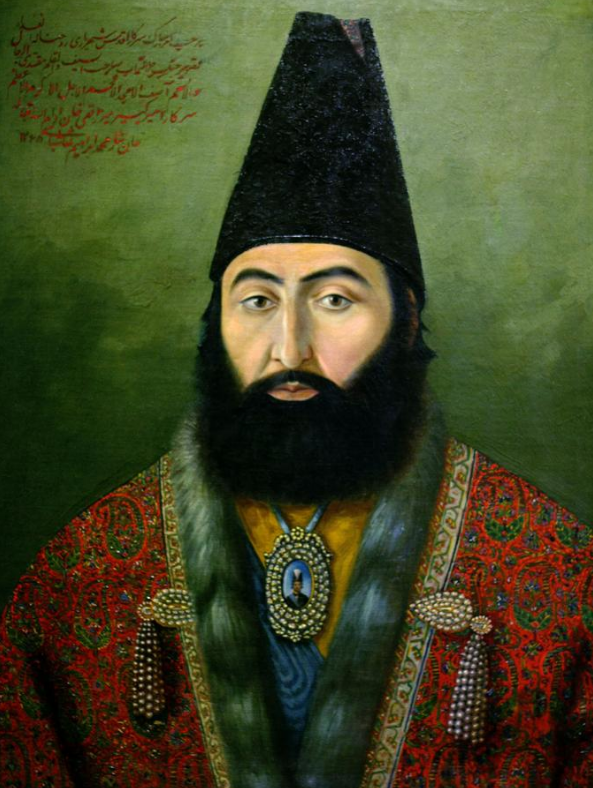
Amir Kabir became prime minister of Naser al-Din Shah Qajar in 1848. He launched a plan for reform in Iran, including the establishment of Dar ul-Fonun, the establishment of the newspaper Vaqayeʿ-ye Ettefaqiyeh, religious reform,[21] the fight against torture,[22] and social reform. The construction of Dar ul-funun was completed two days after the removal of Amir Kabir, who ordered the recruitment of professors from Europe. The arrival of foreign professors such as Jakob Eduard Polack, Alfred Jean Baptiste Lemaire and Johann Louis Schliemer in Iran and the beginning of their work at Dar ul-Fonun University brought Western science and culture to Iran.[23] Mirza Malkam Khan, who was Iran's ambassador to Britain at the time, also returned to Iran to teach at Dar ul-Fonun.[24]
Amir Kabir made a significant contribution to the development of the Persian language as a modern medium.[25] Vaqayeʿ-ye Ettefaqiyeh newspaper became the first modern Iranian newspaper with the publication of world news articles, events page, children and adolescents page, translation of foreign articles. Although after the removal of Amir Kabir, the management fell into the hands of others, but until the newspaper was banned, there was no censorship in articles and news.[26]
Amir Kabir had many problems with ulama during his time as prime minister. They criticized Amir Kabir for opening the Dar al-Fonun, arguing that teaching in the same traditional way as "Maktab Khaneh" was the best way. Although Amir Kabir was the son of a cook and studied secretly, he hated the superstitions and abuses of the ulema.[27] When Amir Kabir limited the power of the clergy, Mirza Abdul-qasem Tehrani opposed him and ordered grant refuge in Shah Abdol-Azim Shrine. In response, Amir Kabir declared it illegal and placed Abdul-qasem Tehrani under house arrest.[28]
Amir Kabir fought against bribery during his ministry. He ordered that the incalculable receipts and unreasonable benefits they received from government agencies be cut off. He reduced the king's salary to two thousand tomans a month. He cut off the incalculability of the previous prime minister, Haji Mirza Aqasi. He reorganized the tax laws and adjusted the income statement. Amir Kabir also confiscated the rights of those who did not pay taxes.[29]
Amir Kabir's presence in Naser al-Din Shah's court was always opposed by a number of the Shah's relatives, including Malik Jahan Khanom, Shah's mother and Mirza Aqa Khan Nuri; As the efforts of these people eventually led to the dismissal of Amir Kabir from his position. Some courtiers, who saw him as against their own interests, slandered Amir Kabir's claim to kingship.
Finally, Amir Kabir was assassinated on Saturday, January 10, 1852 in Fin bathroom of Kashan. They opened the veins of his hands and feet, and after a while of bleeding, Ali Khan Farash pointed to Mir Ghazb. He angrily hit Amir between the two shoulders with his boots. Because Amir hit the ground with a handkerchief in his throat until he died.[30]
3. Pre-Constitutional Intellectuals
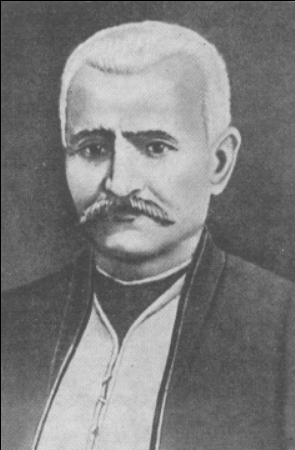
The intellectual background of many thinkers of this period is the works of three philosophers and thoughtful writers named Mirza Fatali Akhundov, Mirza Abdul'Rahim Talibov Tabrizi and Yousuf Khan Mostashar al-Dowleh. These three thinkers were very influential in the thoughts of their future with works on nationalism, secularism and constitutionalism.
Akhundov is best known as the first theorist of Iranian nationalism.[31] He considers the condition of being Iranian not to be a part of Iranian-Islamic culture, but to be a part of the Iranian nation and loyal to the homeland.[32] One of Akhundov's greatest works is his treatise "Mukatebat", in which he explains his controversial theory of libertarianism, in which he believes that every human being who enters the world should enjoy the blessing of complete freedom. He considers complete freedom to consist of two types of freedom: one is spiritual freedom and the other is physical freedom. He believes that religion has taken away spiritual freedom from the people. So in this kind of freedom we are deprived of the blessing of complete freedom. Regarding physical freedom, he believes that the despotic or oppressive rulers have taken it from us and condemned us to accept their affairs in this world; And in this case, too, he believes that we are deprived of the blessings of freedom. He considers the sum of these two spiritual and physical freedoms as complete freedom and says that these cases are explained in general in Western books; And he believes that the people of Asia have been deprived of complete freedom and have lost it, and are completely deprived of the enjoyment of equality and the blessings of human rights, and are unable to understand this deprivation.[33]
Mirza Abdul'Rahim Talibov Tabrizi was one of the intellectuals before the Constitutional Revolution in Iran, who, following Akhundov, at the age of 55, began writing his works in social, nationalist and religious criticism. During his long life, Talibov has gone through a period that should be considered the period of influencing and modeling Western civilization, especially France, on the political, social and economic life of the Iranian people.[34] Hence, one of the most important themes of his works was modeling on Western civilization and at the same time opposing the influence of colonialism. Talibov was best known for his famous book, The Book of Ahmed, in which he was inspired by Jean-Jacques Rousseau's Emile. In this book, Talibov pursues two goals: first, to introduce society to new knowledge and sciences; second, to institutionalize a critical view In society and especially in children. Contrary to the old tradition of education, which did not allow criticism and controversy, Talibov in his book tried to encourage questioning and teach conversation with the child as the only normal way to treat the child.[35] Talibov was very interested in nationalism and, for the first time among Iranians, found freedom in nationalism and saw the concept of nationalism not on the basis of racism, but on the basis of "knowing one's own history and past." Talbov also considered all the people who lived in Iran to be the inheritors of the culture of ancient Iran.[36]
Yousuf Khan Mostashar al-Dowleh, known among first- and second-generation Iranian intellectuals as the "oppressed libertarian,"[37] is one of the pioneers and libertarians of Nasser al-Din Shah's era and the author of the famous book "A Word". A word is known as the first written document of the beginning of modernity in Iran, which was written in 1868, nearly 36 years before the Constitutional Revolution in Paris. Mustashar al-Dawla, himself a member of the Grand Orian Masonic Lodge,[38] selected articles from the French constitution and the French Declaration of Human Rights and Citizenship, and tried to show Iranian clerics and elders that these laws did not contradict the Qur'an and that one could be a Muslim. Accepted a law in which, according to him, the king and the beggar were equal, "A word" is very secular in this respect.[39]
The thoughts of Mostashar al-Dowleh were incompatible with the temperament of Naser al-Din Shah, so he was afflicted with the same fate that befell all libertarians at that time. He was chained and imprisoned in the Rokniyeh mansion in 1891 by Shah. He was alone in prison and was not allowed to meet anyone, not even other prisoners in Qazvin. He was so tortured in prison that he died a few years later in 1895.[40]
4. Developments in the Iranian Educational System

The construction of schools in a new style and the spread of new educational ideas in Iran was one of the most important cultural developments that, despite the opposition of some individuals and groups, was finally accepted in the Iranian cultural system.
One of the first founders of new schools in Iran was Haji-Mirza Hassan Roshdieh, who known as "the father of modern Iranian education"[42] After acquiring new educational techniques, in addition to establishing schools in a new style, Roshdieh introduced new ideas into the Iranian education system and changed the way of reading the alphabet and writing various books for children in a new way. In this way, he had the support of people like Farrokh Khan Amin al-Dawla and Sheikh Hadi Najmabadi. Thanks to these tireless support and efforts, Roshdieh was able to contribute to the development of the education system and its generalization, and to advance the education process towards change.[43]
Roshdieh built eight schools in Tabriz, seven of which were destroyed by clerics. But the eighth school, which was built with the support of Farrokh Khan Amin al-Dawla, remained. The development that Rushdie made in the Iranian education system was that, before him, schools belonged to the aristocracy and government officials, and ordinary people were not allowed to study in schools, instead they had to study in Maktab. but, Roshdieh built schools for the general public.[44]
5. Post-Constitutional Developments in Iran
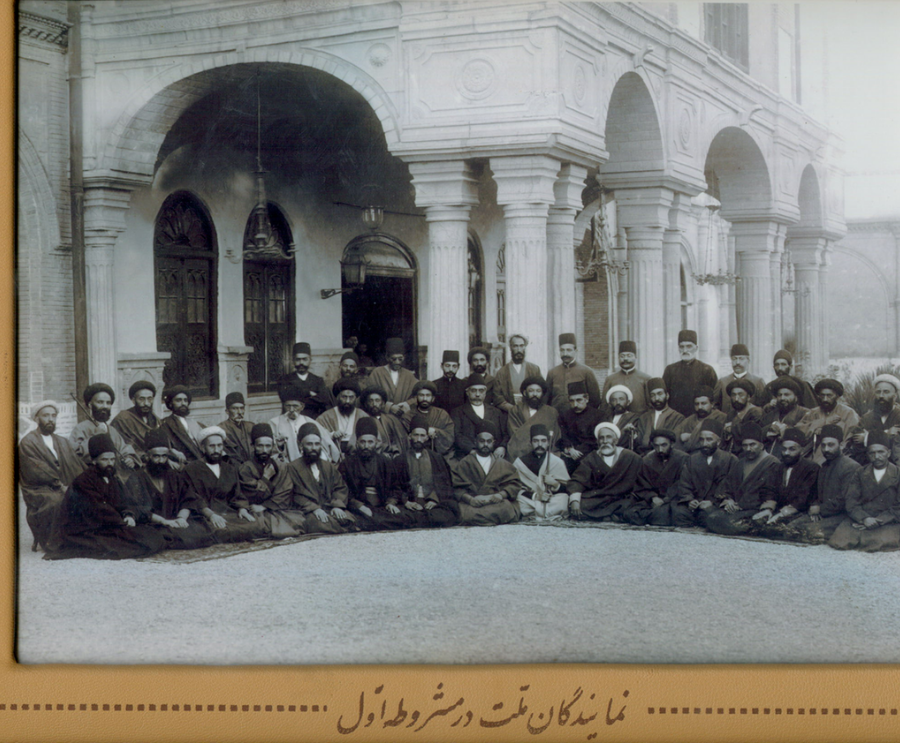
The constitutional movement was formed during the reign of Mozaffar ad-Din Shah and included various strata of the people, businessmen, clerics, peasants and politicians. With the signing of the 1906 constitution by Mozaffar ad-Din Shah, relative freedom of expression was established in Iran. Parliamentary elections were held and the first Majlis began to function. Newspapers and books were published with less censorship, and thinkers no longer saw their lives in danger. With the establishment of the first legislature and the adoption of the constitution, a new round of strife broke out between the proponents of the ancient tradition and the broad front of modernists.[45] In fact, with the victory of the constitutionalist movement, the traditional system was disrupted and the presence of modern concepts was transferred from the realm of thought to the social and political realities of Iran, and many of these modern concepts had nothing to do with of the ancient tradition.[46]
The formation of Majlis was a great change not only in Iran itself, but also in the Middle East. This was the first time that power was divided among different people from different classes in the Middle East, and such a thing had never been seen before in the Middle East. Also, the 1906 constitution of Iran in its time was considered one of the most secular laws passed in a parliament among countries.[47]
5.1. Formation of Social Democratic Party and Modernism Ideas
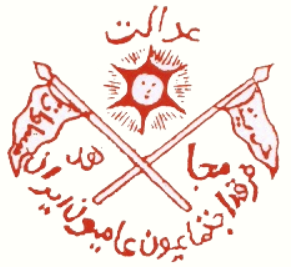
The formation of parliament led to the emergence and growth of intellectual ideas that may not have been possible for them to grow during the tyranny of kings like Naser al-Din Shah, such as secularism, modernism, and nationalism. All these ideas were led in the first term of the parliament by one of the emerging politicians named Seyyed Hassan Taghizadeh. Taghizadeh and his supporters were known for their extremism, intellectualism, and Westernism, hence the name of this minority faction led by Taghizadeh known as, Social Democratic Party.[48]
Social Democratic Party was the first political party, in the modern sense, to emerge in Iran and operate in the early years of parliament. The party had few members, and perhaps had branches in only a few cities. On the other hand, the Social Democrats helped organize a social and anti-authoritarian struggle in Tehran, and were blamed for several terrorist acts. In Gilan and Azerbaijan, they aroused the movement of peasants and craftsmen and organized the Tabriz resistance during the tyranny of Mohammad Ali Shah.[49] In addition, the Social Democrats were the first party, through Seyyed Hassan Taghizadeh, to present a clear political, social, and economic agenda and to describe their organizational form in detail in a code of conduct.[50] Social Democrats, unlike their Moderate Socialists Party rivals, who espoused conservative policies,[51] were extremist in calling for sweeping reforms in Iran in the style of Western governments. They showed their extremism with several assassinations and political sabotages, including the assassination of Shoja Nizam Marandi and his son Shoja Lashkar and the assassination of Amin al-Sultan.[52]
Taghizadeh is compared to George Danton in terms of his passionate speeches and political ideas.[53] Seyyed Hassan Taghizadeh was one of the few intellectuals and politicians active in the Iranian Constitutional Revolution who, in addition to political struggle, was involved in discussions in the field of new political thought and the need to establish a modern Western-style system of government in Iran.[54] Taghizadeh is a controversial figure in the field of opinion and practice during Qajar era. Theoretically, he praised the scientific achievements of the West in its various dimensions, and he considered the unquestioning surrender to Western civilization as the solution to end Iran's backwardness.[55]
5.2. Increasing the Role of Women in Society
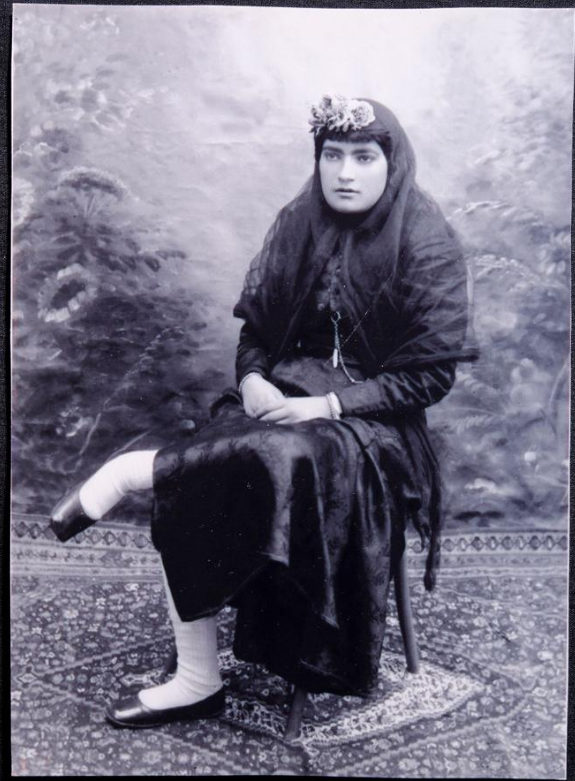
Women were deprived of many of their basic rights for many years, but during the constitutional movement, secret and non-secret women's associations were formed. The goals of these associations were more freedom for women in society and civil equality. At this time, intellectual constitutionalist men such as Mirzadeh Eshghi, Mohammad-Taqi Bahar, Iraj Mirza, and others also supported the women's rights movement, especially in the right to education and the abolition of the hijab.
At a time when reading and writing were considered flawed for women and women's knowledge and research was a sin, Maryam Amid succeeded in launching one of first Iranian women's magazine in 1910 called Shokufeh. The aim of the publication was to acquaint women with literary works, superstition, housekeeping and childcare tips, and to try to improve women's morale.[56] Over time, the magazine's tone became sharper and its protests against the social situation more explicit, such as criticizing the tradition of underage girls marrying and even protesting the interventions of superpowers and encouraging national independence. One of the most important actions of amid, as the editor-in-chief of Shokufeh magazine, was the introduction of women candidates accepted in the third parliamentary elections, which had consequences for her.[57]
Other activities of Maryam Amid include the establishment of a girls' school,[58] the establishment of the Hemmat Association,[59] the elimination of superstitions and the boycott of foreign goods, and the prohibition of the import of such products.[60]
5.3. Poets and Socio-Political Developments
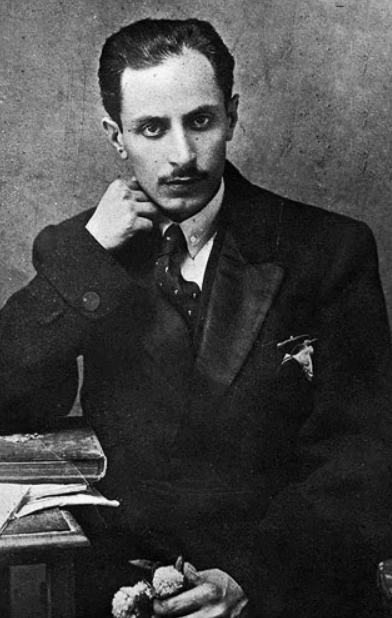
An important influence of the constitutional movement was the existence of libertarians and thinkers who were from the poor or middle class of society. Poets such as Aref Qazvini, Mirzadeh Eshghi and Farrokhi Yazdi are in this category. They strongly criticized the oppression of the people. Among the rich and aristocrats, there were intellectuals like Iraj Mirza who, despite being rich, wrote in a newspaper.[61]
These libertarians were greatly angered by the aristocratic rich who came to power through corruption and bribery. Farrokhi Yazdi composed a poem criticizing Zeygham al-Dawla Qashqa'i, the ruler of Yazd, and in response Zeigham al-Dawla ordered to sew his mouth with thread and needle and throw him in prison.[62]
Aref Qazvini spent his whole life in poverty, but he did not stop composing poetry until he died of an illness. "imprisoned bird's moaning", one of his most famous works, has a liberal aspect and encourages people to resist until victory.[63]
Mirzadeh Eshghi was a very powerful poet, writer, journalist and playwright, who always supported libral Ideas. one of the first Iranian operas, "The Resurrection of the Shahriars of Iran" was written by him.[64] Mirzadeh Eshghi is also one of the first and most prominent intellectuals of the constitutional period to defend women's rights and defend women's freedom and presence in society. He criticized the low rights of women and believed that hijab is a useless legacy of our past.[65]
Iraj Mirza was educated and had political beliefs opposed to the general public and politicians, so he did not engage in political activity, occasionally writing poetry and pursuing government and journalism careers.[66] But during the constitutional movement, he began composing poems in support of the people. Although Iraj Mirza was proud of his ancestry, there are poems left in his critique and slander of Mohammad Ali Shah and Ahmad Shah.[67] Thus, apart from unreasonable love, hate and prejudice, he had made his intellectual and free-thinking personality his profession. He was politically conservative to the extent that he did not harm his own self-interest. But at the same time, he had patriotic and nationalist ideas.[68]
6. Mirza Malkam Khan and Intellectual Movements in Iran
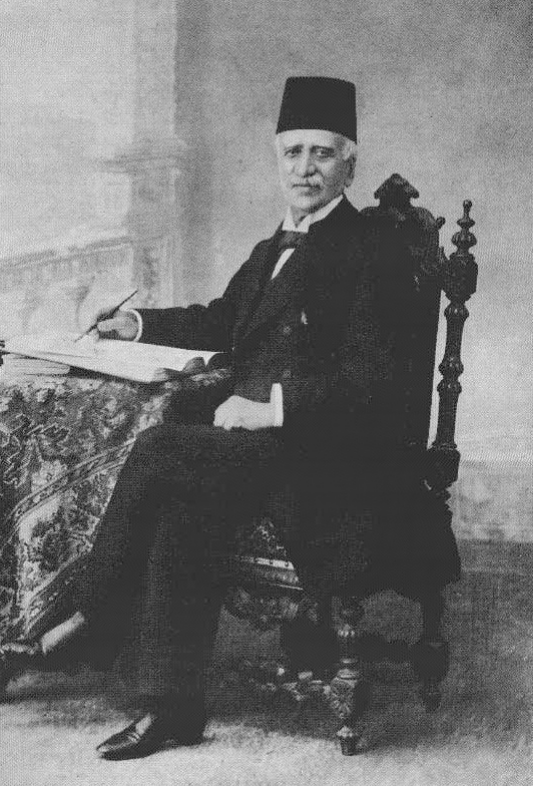
Mirza Malkam Khan is known among contemporary Iranian writers, scholars, and intellectuals as the "father of the Iranian Enlightenment"[69] Mirza Malkam Khan is one of the main and most prominent figures of the first generation of Iranian intellectuals, whose political extension of thought eventually led to the victory of the constitutionalists and the establishment of parliament. There are writings left by Mirza Fatli Akhundov in which he says:
Mirza Fatali Akhundov, (1865)[70]
Mirza Malkam Khan's passionate views are to some extent a diagram of his influence on Rousseau's ideas. A theory that placed a strong emphasis on the awakening of human beings and believed that without freedom and spontaneity, no society would have real value. However, Mirza Malkam Khan soon realized that the implementation of Rousseau ideas in Iran is impossible and ineffective.[71] For this reason, he tried hard to the more practical and applied ideas of modernity, which in the society of Iran at that time, could be turned into political projects and prone to social mobilization.[72]
State bureaucracy, organizing tax affairs, establishing democratic institutions, legalism, moving towards science and technology, establishing a free press, and reforming the army were among the issues that Mirza Malkam Khan sought to pursue and turn into political programs. Mirza Malkam Khan's ideas of modernity are based on shaking and reducing the power of the absolute monarchy, which has been the most powerful ruling class in Iran for centuries. A theory that seemed impracticable without recruiting other powerful classes in Iran and involving them in political participation and intervening in this complex struggle. For this reason, Mirza Malkam Khan, in the second issue of the Qanun newspaper, formally conceived the idea of forming a land that had to be formed between the clergy and the educated to break the domination of the monarchies.[73]
Mirza Malkam Khan was interested in spreading modernity and its values in Iran. Nothing mattered so much in his intellectual life and political activism to modernize Iran. Mirza Malek Khan's way of thinking in the political struggle, which paid much attention to social mobilization, seems to be very similar to the way of thinking Claude Adrien Helvétius, Which advises not to argue with the common people, because during all these years of absolute rule, the thinking of the people has not grown to the extent that they understand the reformists, so the basis of their ultimate goal and their thoughts should be their interests.[74]
Although Malkam Khan in the last decades of his life focused most of his efforts on political activism and the emphasis on building modern institutions in the socio-political structure of Iran, his emphasis on the need for awakening and Iranian activity continued unabated until the end of his life. For all the influences that Malkam Khan had on Iran's entry into political modernity, and for a long time ended the complete intellectual freezing of power, both socially and in the elites, he was attacked by the opposition in the twentieth century for unknown reasons.[75]
Mirza Malkam Khan's thought as the main illuminator of modernity in nineteenth-century Iran, no doubt, like many nineteenth- and early twentieth-century thinkers, influenced the tradition of thought and politicization of Iranian society in the last century and a half. Today, it has played a much stronger role than neighboring countries in accepting democracy, peaceful coexistence, non-violence, avoiding tyranny, and legalizing affairs.[76]
6.1. Faramosh Khaneh
Before Mirza Malkam Khan, Freemasonry existed in Iran, and even Iranians such as Mirza Askar Khan Orumi Afshar and Mirza Abolhassan Khan Ilchi were admitted to the Masonic lodges of England and Scotland.[77] In 1859, Mirza Malkam Khan established the first Masonic lodge in Iran called "Faramosh Khaneh". Its members were from different classes; For example, both the graduates of the Dar ul-Fonun were from the urban middle class and people like Prince Jalaluddin Mirza Qajar. The ideology of this association was rooted in Malkam Khan's teachings of the socio-political teachings of nineteenth-century Europe, especially the French Revolution: teachings such as liberalism and humanism. Despite Malkam Khan's preparations, the wave of opposition rose very quickly. Although the internal organization of the Forgetting House was derived from those Freemasonry lodges in Europe, the Malkam Khan's Faramosh Khaneh had nothing to do with European Freemasonry circles.[78]
In the beginning, many intellectuals of the Qajar period recognized the Freemasonry organization as a modern, revolutionary and Libertarian organization that had no purpose other than to fight against tyranny and to establish democracy and the awakening of nations. One of the important factors that attracted the intellectuals of this period to Freemasonry organizations, especially its French lodge, was the important role of its members in the French Revolution; And since the French Revolution was a valuable example for Iranian revolutionaries and intellectuals, they saw the formation of Faramosh Khaneh and the joining of Freemasonry organizations as a means of transformation, transformation, and revolution in Iran.[79] The Faramosh Khaneh was first established with the permission of Nasser al-Din Shah and provided it was not against the interests of the Shah and the country during the reign of Mirza Aga Khan, one of the defenders of Freemasonry, and flourished during this period. He did not consider it in the interests of the monarchy to continue the activities and ordered its closure, and Mirza Malkam Khan was arrested and exiled to Iraq.[80]
7. Leftist Thinkers
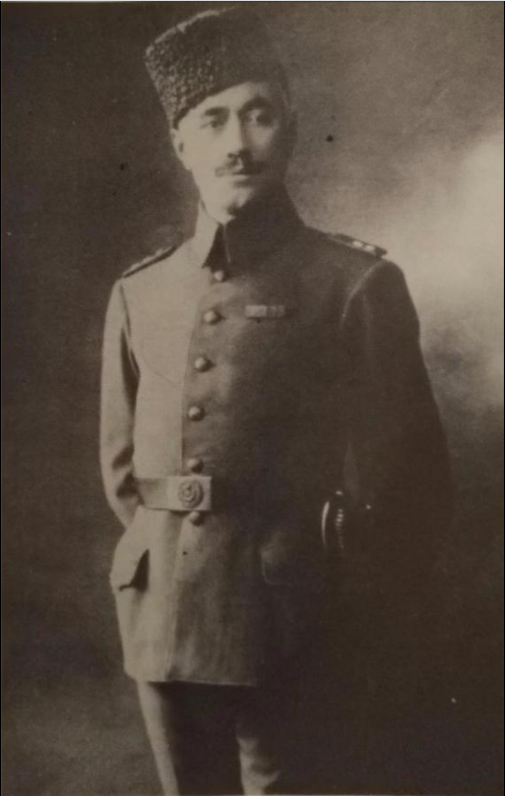
After the victory of the Constitutional Revolution in 1906, leftist ideologies entered Iran, supported by a number of emerging constitutional leaders such as Hassan Taghizadeh and Haydar Khan Amo-oghli. It was at this time that the Social Democratic Party, a remnant of Baku Hemmat party, was formed.[81] However, after a while, Taghizadeh and Amo-oghli clashed over the extremism and assassinations committed by Amo-oghli, which led to the dissolution of the party[82]
Haydar Khan Amo-oghli, known as "the greatest leftist thinker and theorist of Qajar Iran",[83][84] was one of the most influential figures of the Constitutional Revolution and later of the Jungle Movement. Amo-oghli, became acquainted with socialist ideas while studying at the Tbilisi Polytechnic University and became a member of the Russian Social Democratic Workers' Party. Amo-oghli fled to the Caucasus after the defeat of the Russian Revolution of 1905 and founded the Hemmat Party in Baku with Nariman Narimanov.[81] After a while, Haydar Khan returned to Iran and the Hemmat Party became Social Democratic Party. After that, Haydar Khan's terrorist activities[85] began. In 1907, Amin al-Sultan was assassinated by Abbas Agha Tabrizi, a supporter of Haydar Khan.[86] After bombardment of the Majlis, he went to Baku, where he sent volunteers to fight Mohammad Ali Shah and help the Mojahedin of Tabriz, and he himself came to Tabriz. During the battles of Tabriz, he was involved in killing Shojae Nezam Marandi with a bomb.[52]
After Triumph of Tehran, Haydar Khan continued his secret revolutionary activity. In 1910 he went on a secret mission among the Bakhtiari tribe and returned to Tehran in March 1911 and lived there secretly until his whereabouts were identified. He was exiled by order of Yeprem Khan.[87] Heydar Khan went to Russia and from there to France and Switzerland and joined Lenin's colleagues.[88] Haydar Khan participated in the Baku Congress in 1917 after the formation of Bolshevik Russia and formed the first communist party in Iran[89] called Justice Party with Avetis Sultan-Zade. From the very beginning, there were two policies in the party: the faction that gathered around Sultan-zadeh considered Iran on the eve of the socialist revolution, but the more moderate faction, which favored the views of Haydar Khan, believed that Iran was still It is not ready for a socialist revolution and it must go towards a national and democratic revolution. During the Iranian Communists' joining the Jungle Movement, Haydar Khan's policy prevailed and he became the leader of the Communist Party of Iran.[90]
Haydar Khan was finally killed in 1921, his killer was never identified, but it is true that he had many disagreements with Mirza Kuchik Khan. Haydar Khan was initially an extremist socialist who believed in a sweeping reform in Iran. However, after returning from Russia, he turned to moderate communism and worked hard to establish this ideology in Iran. Many leftist thinkers in Iran are still influenced by him because the basis of the ideology of communism in Iran is the same moderation that Haydar Khan agreed with.[91]
Soleiman Eskandari, was one of Haydar Khan's most influential figures, who later strayed far from him in terms of line of thought. Eskandari entered the National Assembly in 1914 as the parliamentary leader of the Democratic Party. But during the prime ministership of Reza Khan Sardar Sepah, he led the Socialist Party. Its members were socialists who had previously supported the Democratic Party and intended to mobilize the middle and lower classes, such as the working class. At a time when members of the Democratic Party, as well as some moderates, were in Qasr Shirin because of the interim government of immigrants, a coalition was formed between them, which was registered as the Socialist Party of Iran. The party effectively replaced the old Democratic Party and announced its existence in the Fourth House in 1921. The Socialist Party of Iran was a minority in that parliament, forming the opposition faction of the Reform Party, which held a majority in parliament. The Socialist Party of Iran was inclined to the socialist policies of Russia, and the Reform Party, consisting of the old moderates and the remnants of the Democrats, was considered a conservative party.[92]
Eskandari was very close to communist thought at first, but after a while there were changes in the Socialist Party that made it completely independent of others. The Socialist Party of Iran was the first party in the history of Iran to defend the abolition of the death penalty. It was also the first party in Iranian history to explicitly mention gender equality in its manifesto, advocating "equal rights for Iranian women and men without distinction of race, religion, nationality before the law."[93] Eskandari's interest in social justice and equality was rooted more than any influence of European thinkers on European Enlightenment or socialism in Islam. He was a devout Muslim and established a customary pilgrimage to Mecca.[94]
8. Bábist Intellectuals
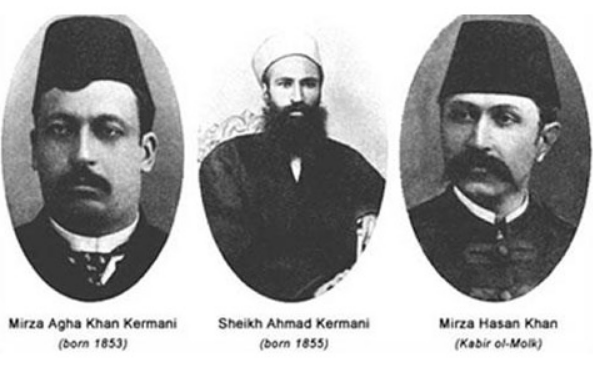
One of the new religions in Iran was Bábism. Bábism movement began following the execution of Sayyid Ali Muhammad Shirazi, known as Báb, and ended in complete killing and bloodshed. But there were several thinkers among the Bábists who were very influential during this period.
Mirza Aqa Khan Kermani was one of the founders of Iranian nationalism, he fled to Istanbul with his colleague Sheikh Ahmad Rouhi and another Bábist writer named Mirza Hassan Khan Tabrizi, and there with Jamāl al- Dīn al-Afghānī began to work together to promote liberal and nationalist ideas. During this period, Jamāl al-Dīn al-Afghānī's fascination with Mirza Aga Khan was evident in all circumstances. But over time, the observation of his lack of work and lack of struggle causes Mirza's failure and despair, as he writes in one of his letters: "Sheikh" Seyyed Jamal "is sitting in his house and several workers are taken from morning to evening to receive people frome Different countries such as Indians, Arabs (he used the term "Tazi" for arabs), Afghans, Egyptians, Iranians, Turks and Sudanese are busy and have nothing else to do."[95] Kermani later seceded from al-Afghānī and, with his new pan-nationalist ideas, wrote several books in which he wished to return to the empires before the Arab invasion of Iran. Kermani became an atheist at the end of his life, and one of the reasons for his execution was that he was an atheist.[96]
Before fleeing to Istanbul, Sheikh Ahmad Rouhi wrote the book Hasht Behesht in Iraq, in which he described the beliefs of Bábism and considered the Constitutional Revolution as a precondition for the downfall of the Qajar dynasty.[97] In this book, he also describes the type of government he wants. The book was saved from extinction by Edward Granville Browne.[98][99]
Mirza Hassan Khan Tabrizi was a writer and former politician who was Iran's consul in the Levant before joining Sheikh Ahmad Rouhi and Mirza Agha Khan Kermani. In Istanbul, due to the existence of printing presses, he was the editor of Iranian freedom-seeking publications from Iran and Britain, and he also corresponded with Bábist and endangered politicians and brought many of them to Istanbul.
After the assassination of Naser al-Din Shah, the Ottomans extradited Sheikh Ahmad Rouhi, Mirza Hassan Khan, and Mirza Aga Khan, who had been imprisoned in Trabzon, to Iran. On July 17, 1896, Crown Prince Mohammad Ali Mirza beheaded them in the northern garden of Tabriz on charges of being Bábist and sent their heads full of straw to Tehran.[100]
Mirza Jahangir Khan was a journalist and writer who hid his religion during the constitutional movement. He was one of the founders of the Anjoman-e Bagh-e Meykadeh, one of the most influential secret societies during the constitutional movement.[101][102] After the signing of the 1906 constitution of Iran by Muzaffar al-Din Shah Qajar, there was a relative freedom of expression, at the same time Jahangir Khan founded the newspaper Sur-e Esrafil and explicitly criticized the policies of Mohammad Ali Shah.[103]
Ali-Akbar Dehkhoda, who was able to work in Sur-e Esrafil with the help of Jahangir Khan, writes about him:
Mirza Jahangir Khan excelled in writing and journalism, fluent but sharp prose. Without any fear, he wrote about the deepest corruption within government institutions. He was always sympathetic to the ignorance of the people.[104]
On the day Colonel Liakhov bombardment the parliament on the orders of Mohammad Ali Shah, Jahangir Khan, along with Malek al-Motakallemin and Qazi Ardaghi, were writing a report for Sur-e Esrafil. They were arrested and executed on June 23, 1908, in front of the Bāgh-e Shāh, after being tortured.[105]
9. Decline
The first generation of intellectual movements had weaknesses that prevented them from ever achieving their goals as they should. They did not have a proper understanding of the backwardness of ordinary people due to their infancy. Suggestions such as simplifying the concept also failed to reach the public. In addition to these, there were many disagreements between intellectual leaders. Other than Mirza Malkam Khan, who had a very good relationship with Mirza Fatali Akhundov and several other intellectuals and wrote letters to all of them, the general intellectuals had a lot of problems to each other on small issues. Nor did the intellectuals succeed in defeating and dominating the spiritual and superstitious sections of society. One of the most important reasons for its formation was the struggle against superstitions and clerics who were anti-intellectual and anti-scholarly. However, in the late Qajar period, the clergy succeeded in re-establishing themselves as intellectuals. Mostly because the repression of intellectuals was carried out by politicians who were also anti-scholarly and anti-intellectual.[106]
The first generation of intellectual movements in Iran continued to prosper until Mohammad Ali Shah bombed the parliament in 1908. Mohammad Ali Shah dealt a fatal blow to the constitutional movement and the intellectual movement by executing many of the great intellectuals of the time, such as Mirza Jahangir Khan. Due to the lack of alternatives to these individuals, Shiite clerics and anti-constitutional politicians soon took over. They also continued to censor and suppress the constitutionalists. Intellectuals such as Mirzadeh Eshghi and Aref Qazvini fled to Istanbul to save their lives. Under Ahmad Shah, the parliament was closed for fourteen years on his orders, causing political unrest. The political turmoil in the capital reached such a level that on the night of July 17, 1910, four people stormed the house of Seyyed Abdollah Behbahani and killed him. Shortly afterwards, the second political assassination took place in Tehran. Ali Mohammad Khan Tarbiat, a writer and journalist from the Democratic Party, was killed. Political turmoil and the escape, assassination, murder and execution of intellectuals all made the constitutional movement and the intellectual movement look broken.[107]
9.1. Transfer to Second Generation
On February 21, 1921, Reza Khan Mirpanj and Zia-ud-Din Tabatabai staged a coup against the Authoritarian government of Fathollah Khan Akbar, which was concluding an agreement with the British. The successful coup led to the establishment of a government led by Prime Minister Zia al-Din Tabatabai and War Minister Reza Khan Sardar Sepah. Zia-ud-Din Tabatabai, however, continued to cooperate with the 1919 agreement, which after 100 days led to his dismissal with the support of members of parliament and the appointment of Reza Khan Sardar Sepah as prime minister.[108] Reza Khan Sardar Sepah's reforms began during his tenure as prime minister, which many intellectuals, including Suleiman Eskandari, considered a "window of hope."[109] On October 31, 1925, in a vote in the fifth parliament of the National Assembly, Reza Khan Sardar Sepah was elected king, which is considered to be the beginning of the second generation of intellectual movements.[110]
References
- Fereydun Adamiyat, The idea of progress and the rule of law, 1973, p. 10-11
- Fereydun Adamiyat, "Mirza Fatali Akhundov's Thoughts", 1970
- Pahnadayan, Shahin. "An overview of the social and economic structure of Qajar Iran". Journal of Political Science Quarterly 38: 173–194. http://psq.kiau.ac.ir/article_532197.html.
- Taheri, Abu al-Qasim (1976). History of British-Iranian trade and political relations from the time of the Ilkhanate to the end of the Qajar dynasty. Tehran: University of Tehran Press. pp. 523.
- Dalini, Javad Mousavi. "The role of the British East India Company in changing the political and economic position of Iran in the Persian Gulf". Journal of the History of Islam and Iran 18: 16–35. http://ensani.ir/fa/article/331270/%D9%86%D9%82%D8%B4-%DA%A9%D9%85%D9%BE%D8%A7%D9%86%DB%8C-%D9%87%D9%86%D8%AF-%D8%B4%D8%B1%D9%82%DB%8C-%D8%A7%D9%86%DA%AF%D9%84%DB%8C%D8%B3-%D8%AF%D8%B1-%D8%AA%D8%BA%DB%8C%DB%8C%D8%B1-%D8%AC%D8%A7%DB%8C%DA%AF%D8%A7%D9%87-%D8%B3%DB%8C%D8%A7%D8%B3%DB%8C-%D9%88-%D8%A7%D9%82%D8%AA%D8%B5%D8%A7%D8%AF%DB%8C-%D8%A7%DB%8C%D8%B1%D8%A7%D9%86-%D8%AF%D8%B1-%D8%AE%D9%84%DB%8C%D8%AC-%D9%81%D8%A7%D8%B1%D8%B3.
- Seyed Hadi Mousavi, Society and market in the era of Naser al-Din Shah with a look at the social and economic situation in the Qajar era, 2019, p. 34-40
- Seyed Hadi Mousavi, Society and market in the era of Naser al-Din Shah with a look at the social and economic situation in the Qajar era, 2019, p. 41
- Madani, Sayed Jalaluddin. "French melody, a passage in the relations between Iran and France in the contemporary history of Iran". Zamaneh Journal 18: 124–140. http://ensani.ir/fa/article/9690/%D9%85%D9%84%D9%88%D8%AF%DB%8C-%D9%81%D8%B1%D8%A7%D9%86%D8%B3%D9%88%DB%8C-%DA%AF%D8%B0%D8%B1%DB%8C-%D8%AF%D8%B1-%D8%B1%D9%88%D8%A7%D8%A8%D8%B7-%D8%A7%DB%8C%D8%B1%D8%A7%D9%86-%D8%A8%D8%A7-%D9%81%D8%B1%D8%A7%D9%86%D8%B3%D9%87-%D8%AF%D8%B1-%D8%AF%D9%88%D8%B1%D8%A7%D9%86-%D9%85%D8%B9%D8%A7%D8%B5%D8%B1.
- Soltanian, Aboutaleb. "The influence and spread of the French language in Iran, relying on the role of schools (from the beginning of the Qajar period to World War I)". University of Gilan Journal of History 4: 111–131. https://www.sid.ir/fa/journal/ViewPaper.aspx?id=190101.
- Karim Mujtahedi, "Voltaire's historical reputation in Iran", 2004
- Eshghi Fatemi, "Saadi's Influence on Voltaire's Works(18th Century French Philosopher)", 2010
- Pioneers of New Thought in Iran: The Age of Iranian Enlightenment, p. 17
- ẒAHIR-AL-DAWLA, EBRĀHIM KHAN Ebrāhim Khan as governor of Kermān. https://www.iranicaonline.org/articles/zahir-al-dawla-ebrahim-khan
- Ali Asghar Shamim, Iran during the Qajar dynasty, 1992, p. 386
- Ghaemi, Jamshid. "The ruling family of Sardar Rafi in Hezar Jarib and Astarabad". Peik Noor Journal of Humanities 2: 76–87. https://www.sid.ir/fa/journal/ViewPaper.aspx?ID=127391.
- Mutufi, Assadollah (1996). Astarabad and Gorgan in the context of Iranian history, a look at 5000 years of history of this region. Derakhshesh Publications. pp. 165–170.
- Torabi, Mohammad (2000). Sardar Rafie Yanehsari, a man who remains unknown. Thoughtful Monthly. pp. 154–156.
- Mir Hosseini, Mohammad Hassan. "The course of political and social developments in Yazd during the constitutional era". Journal of Document Treasure 66: 76–90. http://ensani.ir/fa/article/178882/%D8%B3%DB%8C%D8%B1-%D8%AA%D8%AD%D9%88%D9%84%D8%A7%D8%AA-%D8%B3%DB%8C%D8%A7%D8%B3%DB%8C-%D9%88-%D8%A7%D8%AC%D8%AA%D9%85%D8%A7%D8%B9%DB%8C-%DB%8C%D8%B2%D8%AF-%D8%AF%D8%B1-%D8%AF%D9%88%D8%B1%D8%A7%D9%86-%D9%85%D8%B4%D8%B1%D9%88%D8%B7%D9%87.
- Yazdani, Sohrab (2011). Constitutional patriots. Tehran: Nashr-e Ney. pp. 14. ISBN 978-964-185-083-0.
- Afary, Janet. "Social Democracy and the Constitutional Revolution". Iran Nameh 43: 407–420. https://www.noormags.ir/view/fa/articlepage/363736/%d8%b3%d9%88%d8%b3%db%8c%d8%a7%d9%84-%d8%af%d9%85%d9%88%da%a9%d8%b1%d8%a7%d8%b3%db%8c-%d9%88-%d8%a7%d9%86%d9%82%d9%84%d8%a7%d8%a8-%d9%85%d8%b4%d8%b1%d9%88%d8%b7%db%8c%d8%aa?q=%D9%85%D8%B4%D8%B1%D9%88%D8%B7%D9%87%20%D8%AA%D8%A8%D8%B1%DB%8C%D8%B2&score=21.438622&rownumber=63.
- Amir Kabir and Iran, p. 334
- Fereydun Adamiyat, Amir Kabir and Iran, 2005
- Ekhtiar, Maryam (2001). "Nasir al-Din Shah and the Dar al-Funun: The Evolution of an Institution". International Society of Iranian Studies 34: 153–163. https://www.jstor.org/stable/4311427?seq=1.
- Haqqani, Musa Faqih. "Freemasonry and Persian constitutional movement". Resalat 3: 32–40. https://www.magiran.com/article/1169884.
- AMĪR KABĪR, MĪRZĀ TAQĪ KHAN, Amīr Kabīr made a second indirect contribution to the elaboration of Persian as a modern medium with his foundation of the newspaper Rūz-nāma-ye waqāyeʿ-e ettefāqīya, which survived under different titles until the reign of Moẓaffar-al-dīn Shah. https://iranicaonline.org/articles/amir-e-kabir-mirza-taqi-khan
- Amir Kabir and Iran, p. 336
- Behbahani, Seyyed Ali. "Secretary who became Prime Minister". Zamaneh Journal 28: 23–29. http://ensani.ir/fa/article/10401/%D8%AF%D8%A8%DB%8C%D8%B1%DB%8C-%DA%A9%D9%87-%D8%B5%D8%AF%D8%B1%D8%A7%D8%B9%D8%B8%D9%85-%D8%B4%D8%AF.
- Kermani, Nazim al-Islam (1909). History of the Iranian Enlightenment. pp. 123.
- Economic history of Iran, p. 141
- Amir Kabir and Iran, p 423
- Pourzaki, Giti. "Modernity and Mirza Fath Ali Khan Akhundzadeh". Persian Journal of History Research 9: 67–79. http://ensani.ir/fa/article/280968/%D9%85%D8%AF%D8%B1%D9%86%DB%8C%D8%AA%D9%87-%D9%88-%D9%85%DB%8C%D8%B1%D8%B2%D8%A7-%D9%81%D8%AA%D8%AD%D8%B9%D9%84%DB%8C-%D8%AE%D8%A7%D9%86-%D8%A2%D8%AE%D9%88%D9%86%D8%AF%D8%B2%D8%A7%D8%AF%D9%87.
- Zia-Ebrahimi, Reza (2016). The emergence of Iranian nationalism: Race and the politics of dislocation. New York: Columbia University Press. pp. 36–38.
- Fereydun Adamiyat, Mirza Fath-Ali Akhundzadeh Thoughts, p. 234, 1970
- Vahdat, Farzin. "The initial confrontation of Iranian intellectuals with modernity: (a dual approach)". Goftogo Journal 30: 125–165. https://www.noormags.ir/view/fa/articlepage/357217/%d8%b1%d9%88%db%8c%d8%a7%d8%b1%d9%88%db%8c%db%8c-%d8%a7%d9%88%d9%84%db%8c%d9%87-%d8%b1%d9%88%d8%b4%d9%86%d9%81%da%a9%d8%b1%db%8c-%d8%a7%db%8c%d8%b1%d8%a7%d9%86-%d8%a8%d8%a7-%d9%85%d8%af%d8%b1%d9%86%db%8c%d8%aa%d9%87-%db%8c%da%a9-%d8%b1%d9%88%db%8c%da%a9%d8%b1%d8%af-%d8%af%d9%88%da%af%d8%a7%d9%86%d9%87.
- Dadkhah, Hassan; Alam, Mohammad Reza; Tangestani, Masoumeh. "An Introduction to the History of Transformation and Modernity in Iran and Egypt with Emphasis on the Views of Talibov Tabrizi and Rifa'a al-Tahtawi". Journal of Comparative Literature Studies 39: 65–82. https://www.noormags.ir/view/fa/articlepage/1132815/%d8%af%d8%b1%d8%a2%d9%85%d8%af%db%8c-%d8%a8%d8%b1-%d8%aa%d8%a7%d8%b1%db%8c%d8%ae-%d8%aa%d8%ad%d9%88%d9%84-%d9%88-%d9%86%d9%88%da%af%d8%b1%d8%a7%db%8c%db%8c-%d8%af%d8%b1-%d8%a7%db%8c%d8%b1%d8%a7%d9%86-%d9%88-%d9%85%d8%b5%d8%b1-%d8%a8%d8%a7-%d8%aa%d8%a3%da%a9%db%8c%d8%af-%d8%a8%d8%b1-%d8%af%db%8c%d8%af%da%af%d8%a7%d9%87-%d9%87%d8%a7%db%8c-%d8%b9%d8%a8%d8%af%d8%a7%d9%84%d8%b1%d8%ad%db%8c%d9%85-%d8%b7%d8%a7%d9%84%d8%a8%d9%88%d9%81-%d9%88-%d8%b1%d9%81%d8%a7%d8%b9%d9%87-%d8%b7%d9%87%d8%b7%d8%a7%d9%88%db%8c.
- Kia, Mehrdad (1994). "Nationalism, Modernism and Islam in the Writings of Talibov-i Tabrizi". Middle Eastern Studies 30 (2): 201–223. ISSN 0026-3206. https://www.jstor.org/stable/4283631.
- Arqandi, Alireza; Ameri Golestani, Hamed. "Foundations of Mirza Yusuf Khan's legalist thought". Journal of Political and International Research 4: 27–62. https://www.sid.ir/fa/journal/ViewPaper.aspx?id=129886.
- Raeen, Esmaeel (1978). Faramosh Khaneh and Freemasonry in Iran. 1. Amirkabir. pp. 479. ISBN 9649102612.
- Azghandi, Alireza. "Foundations of Mirza Yusuf Khan's legalist thought". Journal of Political and International Research 4: 27–62. https://www.sid.ir/fa/journal/ViewPaper.aspx?id=129886.
- Pashazadeh, Qulam ali. "A treatise by Mirza Yusef Khan Mustasharadullah". Zamaneh Journal of History 4: 23–30. http://ensani.ir/fa/article/214067/%D8%B1%D8%B3%D8%A7%D9%84%D9%87-%D8%A7%DB%8C-%D8%A7%D8%B2-%D9%85%DB%8C%D8%B1%D8%B2%D8%A7-%DB%8C%D9%88%D8%B3%D9%81-%D8%AE%D8%A7%D9%86-%D9%85%D8%B3%D8%AA%D8%B4%D8%A7%D8%B1%D8%A7%D9%84%D8%AF%D9%88%D9%84%D9%87.
- Azerbaijani writers in constitutional movement, p. 468
- Yazdani, Sohrab. "A reflection on the educational views of Mirza Hassan Roshdieh". Journal of Iranian History 4: 115–131. https://www.sid.ir/fa/journal/ViewPaper.aspx?id=184743.
- Sazmand, Dariush (2019). Mirza Hassan Rushdieh, the founder of modern schools in Iran. Tehran: Danjeh Publications. ISBN 978-600-250-211-7.
- Samadi, Hamid. "Mirza Hassan Roshdieh, the father of Iranian education". Journal of Education 2: 188–189. https://www.noormags.ir/view/fa/articlepage/255867/%d9%85%db%8c%d8%b1%d8%b2%d8%a7-%d8%ad%d8%b3%d9%86-%d8%b1%d8%b4%d8%af%db%8c%d9%87-%d9%be%d8%af%d8%b1-%d9%85%d8%b9%d8%a7%d8%b1%d9%81-%d8%a7%db%8c%d8%b1%d8%a7%d9%86.
- Seyyd Javad Tabatabai, Fundamentals of Constitutional Theory: A Reflection on Iran, vol. 2, p. 213
- Ali Gheissari, Iranian intellectuals in the twentieth century (from constitutionalism to the end of the monarchy), 2010
- Muhammad Amini, The importance of the Iranian Constitutional Revolution in the Middle East, p.45, 2013
- Salmasizadeh, Mohammad; Aminnejad Najafian, Mohammad. "The first National Assembly and the attempt to explain constitutional rights". Journal of the History of Islam and Iran New Era 14: 76–80. http://ensani.ir/fa/article/326161/%D9%85%D8%AC%D9%84%D8%B3-%D8%A7%D9%88%D9%84-%D8%B4%D9%88%D8%B1%D8%A7%DB%8C-%D9%85%D9%84%DB%8C-%D9%88-%D8%AA%D9%84%D8%A7%D8%B4-%D8%A8%D8%B1%D8%A7%DB%8C-%D8%AA%D8%A8%DB%8C%DB%8C%D9%86-%D8%AD%D9%82%D9%88%D9%82-%D8%A7%D8%B3%D8%A7%D8%B3%DB%8C.
- Aliyev, Saleh; Azmoudeh, Abolfazl. "The plans of Social Democratic Party". Ayandeh Journal of History 5: 176–180. http://ensani.ir/fa/article/256696/%D9%85%D8%B1%D8%A7%D9%85%D9%86%D8%A7%D9%85%D9%87-%D8%AD%D8%B2%D8%A8-%D8%A7%D8%AC%D8%AA%D9%85%D8%A7%D8%B9%DB%8C%D9%88%D9%86-%D8%B9%D8%A7%D9%85%DB%8C%D9%88%D9%86.
- Yazdani, Sohrab. "About Social Democratic Party of Iran". History Journal of Mahallat Azad University 3: 153–161. http://ensani.ir/fa/article/238568/%D8%AF%D8%B1%D8%A8%D8%A7%D8%B1%D9%87-%D9%81%D8%B1%D9%82%D9%87-%D8%A7%D8%AC%D8%AA%D9%85%D8%A7%D8%B9%DB%8C%D9%88%D9%86-%D8%B9%D8%A7%D9%85%DB%8C%D9%88%D9%86-%D8%A7%DB%8C%D8%B1%D8%A7%D9%86.
- Tolli, Zahra; Shipri, Maryam. "Stage analysis such as methods of resolving disputes between the two parties, Social Democratic Party and Moderate Socialists Party in the Second National Assembly of Iran". Journal of Historical Sociology 2: 132–161. http://ensani.ir/fa/article/344046/%D8%AA%D8%AD%D9%84%DB%8C%D9%84-%D9%81%D8%A7%D8%B2%DB%8C-%D8%B4%DB%8C%D9%88%D9%87-%D9%87%D8%A7%DB%8C-%D8%AD%D9%84-%D8%A7%D8%AE%D8%AA%D9%84%D8%A7%D9%81-%D8%A8%DB%8C%D9%86-%D8%AF%D9%88-%D8%AD%D8%B2%D8%A8-%D8%AF%D9%85%D9%88%DA%A9%D8%B1%D8%A7%D8%AA-%D9%88-%D8%A7%D8%AC%D8%AA%D9%85%D8%A7%D8%B9%DB%8C%D9%88%D9%86-%D8%A7%D8%B9%D8%AA%D8%AF%D8%A7%D9%84%DB%8C%D9%88%D9%86-%D8%AF%D8%B1-%D9%85%D8%AC%D9%84%D8%B3-%D8%AF%D9%88%D9%85-%D8%B4%D9%88%D8%B1%D8%A7%DB%8C-%D9%85%D9%84%DB%8C-%D8%A7%DB%8C%D8%B1%D8%A7%D9%86-%D9%85%D8%B7%D8%A7%D9%84%D8%B9%D8%A9-%D9%85%D9%88%D8%B1%D8%AF%DB%8C-%DA%A9%D8%B4%D9%85%DA%A9%D8%B4-%D8%AE%D9%84%D8%B9-%D8%B3%D9%84%D8%A7%D8%AD-%D9%85%D8%AC%D8%A7%D9%87%D8%AF%DB%8C%D9%86-%D9%BE%D8%A7%D8%B1%DA%A9-%D8%A7%D8%AA%D8%A7%D8%A8%DA%A9-.
- Navabi, Abdul'Hossayn. "A sheet of constitutional history: Haydar Khan Amo-oghli and Rasoulzadeh". Yadegar Journal of History 4: 41–50. http://ensani.ir/fa/article/239528/%D9%88%D8%B1%D9%82%DB%8C-%D8%A7%D8%B2-%D8%AA%D8%A7%D8%B1%DB%8C%D8%AE-%D9%85%D8%B4%D8%B1%D9%88%D8%B7%D9%87-%D8%AD%DB%8C%D8%AF%D8%B1%D8%AE%D8%A7%D9%86-%D8%B9%D9%85%D9%88%D8%A7%D9%88%D8%BA%D9%84%DB%8C-%D9%88-%D8%B1%D8%B3%D9%88%D9%84-%D8%B2%D8%A7%D8%AF%D9%87.
- Afshar, Iraj (1975). "Seyyed Hassan Taqizadeh". Yaghma Journal of Political history of Iran 12: 56–69. http://ensani.ir/fa/article/280591/%D8%B3%DB%8C%D8%AF-%D8%AD%D8%B3%D9%86-%D8%AA%D9%82%DB%8C-%D8%B2%D8%A7%D8%AF%D9%87.
- Mohammadzadeh, Ali. "Sociological Analysis of Seyyed Hassan Taghizadeh's Political Thought and Action (Relying on the Constitutional Revolution)". Journal of Historical Sociology 1: 122–157. http://ensani.ir/fa/article/344053/%D8%AA%D8%AD%D9%84%DB%8C%D9%84-%D8%AC%D8%A7%D9%85%D8%B9%D9%87-%D8%B4%D9%86%D8%A7%D8%AE%D8%AA%DB%8C-%D8%A7%D9%86%D8%AF%DB%8C%D8%B4%D9%87-%D9%88-%DA%A9%D9%86%D8%B4-%D8%B3%DB%8C%D8%A7%D8%B3%DB%8C-%D8%B3%DB%8C%D8%AF-%D8%AD%D8%B3%D9%86-%D8%AA%D9%82%DB%8C-%D8%B2%D8%A7%D8%AF%D9%87-%D8%A8%D8%A7-%D8%AA%DA%A9%DB%8C%D9%87-%D8%A8%D8%B1-%D8%AF%D9%88%D8%B1%D8%A9-%D9%85%D8%B4%D8%B1%D9%88%D8%B7%DB%8C%D8%AA-.
- Khunia, Bardia. "A page from the history of constitutionalism: (Letter from Seyed Hassan Taghizadeh)". Yaghma Journal of Political history of Iran 2: 132–145. http://ensani.ir/fa/article/279319/%D8%B5%D9%81%D8%AD%D9%87-%D8%A7%DB%8C-%D8%A7%D8%B2-%D8%AA%D8%A7%D8%B1%DB%8C%D8%AE-%D9%85%D8%B4%D8%B1%D9%88%D8%B7%DB%8C%D8%AA-%D9%86%D8%A7%D9%85%D9%87-%D8%A7%DB%8C-%D8%A7%D8%B2-%D8%B3%DB%8C%D8%AF-%D8%AD%D8%B3%D9%86-%D8%AA%D9%82%DB%8C-%D8%B2%D8%A7%D8%AF%D9%87-.
- Haqiqat Abdul'Rafie, The first female journalist in Iran, p. 137, 1973
- Camron Michael Amin: The Making of the Modern Iranian Woman:Gender, State Policy, and Popular Culture, 1865–1946, Gainesville 2002, p. 41.
- Ettehadieh, M. (2004) The Origins and Development of the Women's Movement in Iran, 1906–41. In: L. Beck and G. Nashat, eds. Women in Iran from 1800 to the Islamic Republic. University of Illinois Press, pp. 85–106. Available through https://books.google.co.uk/books?id=tLRgXf_e_CEC&pg=PA85&lpg=PA85&dq=%22origins+and+development+of+the+women%27s+movement+in+iran+go+back+to+the%22&source=bl&ots=iiA8KSlJBa&sig=ACfU3U3P8h42KQn_nMREtDJZ3p3UQSYohQ&hl=en&sa=X&ved=2ahUKEwigv9q-5fToAhWEYsAKHfSNBxAQ6AEwAHoECAIQKA#v=onepage&q=%22origins%20and%20development%20of%20the%20women's%20movement%20in%20iran%20go%20back%20to%20the%22&f=false [Accessed April 19, 2020].
- Keddie, N.R. (2012) Women in the Middle East: Past and Present. Princeton University Press. Available through: https://books.google.com.pk/books?id=L-T-ng2v47QC&pg=PA85&lpg=PA85&dq=Maryam+Amid&source=bl&ots=Wr8cqnmByp&sig=ACfU3U1yVVgATI-Gub-DVegkfbzLhrNb-Q&hl=en&sa=X&ved=2ahUKEwj5le3I8N3oAhXHDGMBHdX-DM84ChDoATADegQICxAw#v=onepage&q=Maryam%20Amid&f=false [Accessed April 19, 2020].
- The biography of the first female Iranian journalist. http://www.beytoote.com/scientific/scientist/first-1woman1-journalist.html
- Mohammad Jafar Mahjoub, Research on the life, thoughts, works and poems of Iraj Mirza and his family and ancestors, p. 213
- FARROḴĪ YAZDĪ https://iranicaonline.org/articles/farroki-yazdi
- Arshad Tahmasbi, Aref's Tasnifs, 1996
- ʿEŠQĪ, MOḤAMMAD-REŻĀ MĪRZĀDA https://www.iranicaonline.org/articles/esqi-mohammad-reza-mirzada
- Muhammad Qaeed, Mirzadeh Eshghi, the noble face of an anarchist, p. 19
- Hassanzadeh Mir Ali, Abdullah. "The effect of social class on the poetry of the poets of the constitutional period focusing on the poems of "Iraj Mirza" and "Farrokhi Yazdi"". Journal of Persian Language and Literature Research 39: 123–130. http://ensani.ir/fa/article/362788/%D8%AA%D8%A3%D8%AB%DB%8C%D8%B1-%D8%B7%D8%A8%D9%82%D9%87-%D8%A7%D8%AC%D8%AA%D9%85%D8%A7%D8%B9%DB%8C-%D8%A8%D8%B1-%D8%B4%D8%B9%D8%B1-%D8%B4%D8%A7%D8%B9%D8%B1%D8%A7%D9%86-%D8%AF%D9%88%D8%B1%D9%87-%D9%85%D8%B4%D8%B1%D9%88%D8%B7%D9%87-%D8%A8%D8%A7-%D8%AA%D9%85%D8%B1%DA%A9%D8%B2-%D8%A8%D8%B1-%D8%A7%D8%B4%D8%B9%D8%A7%D8%B1-%D8%A7%DB%8C%D8%B1%D8%AC-%D9%85%DB%8C%D8%B1%D8%B2%D8%A7-%D9%88-%D9%81%D8%B1%D8%AE%DB%8C-%DB%8C%D8%B2%D8%AF%DB%8C-.
- Seyyd Hadi Haeeri, Thoughts and works of Iraj Mirza, p. 34 1987
- Naser al-Din, Parvin. "Journalism and poetry of Iraj Mirza". Kelk Journal 67: 239–241. https://www.noormags.ir/view/fa/articlepage/298289/%d8%b1%d9%88%d8%b2%d9%86%d8%a7%d9%85%d9%87-%d9%86%da%af%d8%a7%d8%b1%db%8c-%d9%88-%d8%b5%d8%af%d8%b1%d8%a7%d9%84%d8%b4%d8%b9%d8%b1%d8%a7%db%8c%db%8c-%d8%a7%db%8c%d8%b1%d8%ac-%d9%85%db%8c%d8%b1%d8%b2%d8%a7.
- Taheri Moghaddam, Seyyed Mohammad; Buchani, Ebrahim. "Mirza Malkam Khan Nazim al-Dawlah and a reflection on his educational ideas". Journal of Historical Research 1: 165–180. http://ensani.ir/fa/article/342893/%D9%85%DB%8C%D8%B1%D8%B2%D8%A7-%D9%85%D9%84%DA%A9%D9%85-%D8%AE%D8%A7%D9%86-%D9%86%D8%A7%D8%B8%D9%85-%D8%A7%D9%84%D8%AF%D9%88%D9%84%D9%87-%D9%88-%D8%AA%D8%A3%D9%85%D9%84%DB%8C-%D8%A8%D8%B1-%D8%A7%D9%86%D8%AF%DB%8C%D8%B4%D9%87-%D9%87%D8%A7%DB%8C-%D8%A2%D9%85%D9%88%D8%B2%D8%B4%DB%8C-%D8%A7%D9%88.
- Ali Asghar Haqdar, Letters of Mirza Malkam Khan Nazim al-Dawlah, p. 201, 2017
- Jamalzadeh, Naser; Montazeri, Mostafa. "A Study of the Political-Cultural Doctrine of Mirza Malek Khan Nazim al-Dawlah". Journal of Political Studies 4: 163–192. https://www.sid.ir/fa/journal/ViewPaper.aspx?id=224849.
- Aqa Hosseini, Alireza; Mehdipour, Asiya. "Breaking the foundation of the discourse of the first wave of intellectuals in Iran: Mirza Malkam Khan, Akhundzadeh and Mirza Aqa Khan Kermani". Journal of the Department of Political Science, University of Isfahan 9: 45–58. https://www.sid.ir/fa/journal/ViewPaper.aspx?ID=352170.
- "Malkum Khan was influenced by development ideas in Istanbul" (in fa). http://tarikhirani.ir/fa/news/7942/%D9%85%D9%84%DA%A9%D9%85-%D8%AE%D8%A7%D9%86-%D9%85%D8%AA%D8%A7%D8%AB%D8%B1-%D8%A7%D8%B2-%D8%A7%DB%8C%D8%AF%D9%87-%D9%87%D8%A7%DB%8C-%D8%AA%D9%88%D8%B3%D8%B9%D9%87-%D8%AF%D8%B1-%D8%A7%D8%B3%D8%AA%D8%A7%D9%86%D8%A8%D9%88%D9%84-%D8%A8%D9%88%D8%AF.
- Deilami Moezzi, Amin. "West and modernity from the perspective of Mirza Malkam Khan". Azad University journal of Scientific-research 47: 127–140. https://www.noormags.ir/view/fa/articlepage/1434363/%d8%ba%d8%b1%d8%a8-%d9%88-%d9%85%d8%af%d8%b1%d9%86%db%8c%d8%aa%d9%87-%d8%a7%d8%b2-%d9%85%d9%86%d8%b8%d8%b1-%d9%85%db%8c%d8%b1%d8%b2%d8%a7-%d9%85%d9%84%da%a9%d9%85-%d8%ae%d8%a7%d9%86.
- Hujjatullah Asil, Treatises of Mirza Malkam Khan Nazim Al-Dawlah, p. 512
- Safa'i, Ibrahim (1963). Mirza Malkum Khan.. Tihran, Chap-i sharq. pp. 56–60. ISBN 1-84511-072-2.
- Esmaeel Raeen, Faramosh Khane and Freemasonry in Iran, vol. 1, p. 354
- Hassan Qazi Muradi, Malkam Khan: Theorist of political modernization in the constitutional era, p. 58-64
- Mohammad Ali Akbari, Challenges of the modern era in the Qajar Iran, p. 96
- Ibrahim Sadeghi Nia, Freemasonry and secret societies in Iran, p. 24
- EJTEMĀʿĪŪN, FERQA-YE https://iranicaonline.org/articles/ejtemaiun
- History of the Iranian Constitutional Revolution, vol. 1 p. 334, 2003
- Aghazadeh, Jafar. "The role of Haydar Khan Amo-oghli in Jungle movement". Journal of Historical Research 1: 56–70. http://ensani.ir/fa/article/335281/%D9%86%D9%82%D8%B4-%D8%AD%DB%8C%D8%AF%D8%B1%D8%AE%D8%A7%D9%86-%D8%B9%D9%85%D9%88%D8%A7%D9%88%D8%BA%D9%84%DB%8C-%D8%AF%D8%B1-%D9%86%D9%87%D8%B6%D8%AA-%D8%AC%D9%86%DA%AF%D9%84.
- "Analysis of reports of the Mollasera incident and the murder of Haydar Khan Amo-oghli in the Jungle Movement". Journal of Ferdowsi University of Mashhad 3: 54–65. https://civilica.com/doc/1026239/.
- Esmaeel Raeen, Haydar Khan Amo-oghli, p. 86 1976
- ḤAYDAR KHAN ʿAMU-OḠLI https://iranicaonline.org/articles/haydar-khan-amu-ogli
- Khalatbari, Mustafa. "A review of the story of Haydar Khan Amo-oghli". Farafu Journal of History 2: 45–57. https://web.archive.org/web/20180202071651/http://fararu.com/fa/news/50966/%D9%85%D8%B1%D9%88%D8%B1%D9%89-%D8%A8%D8%B1-%D8%B3%D8%B1%DA%AF%D8%B0%D8%B4%D8%AA-%D8%AD%D9%8A%D8%AF%D8%B1%D8%AE%D8%A7%D9%86-%D8%B9%D9%85%D9%88-%D8%A7%D9%88%D8%BA%D9%84%D9%89.
- Gregor Yaghikian, Soviet Union and Jungle Movement, p. 49 1984
- Lenczowski, George (1949). Russia and the West in Iran, 1918-1948. Greenwood Press. pp. 348. ISBN 0-8371-0144-1. https://www.google.com/books/edition/Russia_and_the_West_in_Iran_1918_1948/XQAOAQAAMAAJ?hl=en.
- Cosroe Chaqueri, The Soviet Socialist Republic of Iran, 1920-1921: The Birth of Trauma. Pittsburgh, PA: University of Pittsburgh Press, 1995; pg. 476.
- Welle (www.dw.com), Deutsche. "تاثیر انقلاب اکتبر روسیه بر جنبشهای انقلابی در ایران | DW | November 6, 2017" (in fa-IR). https://www.dw.com/fa-ir/%D8%AA%D8%A7%D8%AB%DB%8C%D8%B1-%D8%A7%D9%86%D9%82%D9%84%D8%A7%D8%A8-%D8%A7%DA%A9%D8%AA%D8%A8%D8%B1-%D8%B1%D9%88%D8%B3%DB%8C%D9%87-%D8%A8%D8%B1-%D8%AC%D9%86%D8%A8%D8%B4%D9%87%D8%A7%DB%8C-%D8%A7%D9%86%D9%82%D9%84%D8%A7%D8%A8%DB%8C-%D8%AF%D8%B1-%D8%A7%DB%8C%D8%B1%D8%A7%D9%86/a-41066935.
- Ervand Abrahamian, Iran Between Two Revolutions, p. 107-117
- Mohammad Ali Soltani, "Secret Political Parties and Associations in Kermanshah from Faramosh Khaneh to the Black House: Periods of 5-1 National Assembly Elections and Shouters in the Name of Dictatorship from Kermanshah" (2 volumes), Tehran: Saha Publishing Cultural Institute, First Edition : 1999; Page 231. ISBN:9789646254299
- ESKANDARĪ, SOLAYMĀN (MOḤSEN) MĪRZĀ https://iranicaonline.org/articles/eskandari-solayman-mohsen-mirza
- Fereydun Adamiyat, "Mirza Aqa Khan Kermani's Thoughts", 1978
- "ĀQĀ KHAN KERMĀNĪ". http://www.iranicaonline.org/articles/aqa-khan-kermani-iranian-writer-and-intellectual-d-1896.
- Sayyd Muqdad Nabavi Rezai, "Once upon a time, Bábism's endeavors", 2014
- "Brown showed me his copy of the rare book, Hasht Behesht. I was amazed at how he managed to save this book from the clutches of short-sighted fanatics!" Biography of Mirza Malkam Khan, his life and political efforts, p. 234 (1934)
- Javadi, Hassan. "Malkam and Brown; The role of Qanun newspaper in Iranian Enlightenment". Persian History Journal 5: 23–30. http://tarikhirani.ir/fa/news/7945/%D9%85%D9%84%DA%A9%D9%85-%D9%88-%D8%A8%D8%B1%D8%A7%D9%88%D9%86-%D9%86%D9%82%D8%B4-%D8%B1%D9%88%D8%B2%D9%86%D8%A7%D9%85%D9%87-%D9%82%D8%A7%D9%86%D9%88%D9%86-%D8%AF%D8%B1-%D8%A8%DB%8C%D8%AF%D8%A7%D8%B1%DB%8C-%D8%A7%DB%8C%D8%B1%D8%A7%D9%86%DB%8C%D8%A7%D9%86.
- ĀQĀ KHAN KERMĀNĪ https://iranicaonline.org/articles/aqa-khan-kermani
- Mehdi Malekzadeh, Life of Malek al-Motakallemin, p. 300
- Ahmad Kasravi, History of the Iranian Constitutional Revolution, 1940, p. 243
- Sabzipur, Amir. "Review of Sur-e Esrafil Weekly". Tarikh dar Ayeneh Journal 21: 123–130. http://ensani.ir/fa/article/46437/%D8%A8%D8%B1%D8%B1%D8%B3%DB%8C-%D9%87%D9%81%D8%AA%D9%87-%D9%86%D8%A7%D9%85%D8%A9-%D8%B5%D9%88%D8%B1-%D8%A7%D8%B3%D8%B1%D8%A7%D9%81%DB%8C%D9%84.
- Kamyar Abedi, Sur-e Esrafil and Ali Akbar Dehkhoda, a historical and literary study, p. 96
- Khosravi, Rokneddin. "Roads of Freedom Riders, in memory of: Jahangir Khan Sur Israfil". Chista Journal 50: 801–814. http://ensani.ir/fa/article/263804/%D8%B1%D8%A7%D9%87-%D8%B3%D9%88%D8%A7%D8%B1%D8%A7%D9%86-%D8%A2%D8%B2%D8%A7%D8%AF%DB%8C-%DB%8C%D8%A7%D8%AF%DB%8C-%D8%A7%D8%B2-%D8%AC%D9%87%D8%A7%D9%86%DA%AF%DB%8C%D8%B1%D8%AE%D8%A7%D9%86-%D8%B5%D9%88%D8%B1-%D8%A7%D8%B3%D8%B1%D8%A7%D9%81%DB%8C%D9%84.
- Amin Pour, Sajjad; Ghorbanzadeh Savar, Ghorban Ali. "The main demand of the first generation of Iranian intellectuals: limiting the power of the monarchy". Journal of Government Studies 13: 173–192. https://www.sid.ir/fa/journal/ViewPaper.aspx?id=356052.
- Pouzesh, Mohammad. "A study of the intellectual currents of the constitutional era". Kharazmi History Journal 1: 93–117. http://ensani.ir/fa/article/360705/%D8%A8%D8%B1%D8%B1%D8%B3%DB%8C-%D8%AC%D8%B1%DB%8C%D8%A7%D9%86-%D9%87%D8%A7%DB%8C-%D9%81%DA%A9%D8%B1%DB%8C-%D8%B9%D8%B5%D8%B1-%D9%85%D8%B4%D8%B1%D9%88%D8%B7%D9%87.
- Ghani, Cyrus (1998). Iran and the Rise of Reza Shah. I.B.Tauris. pp. 319. ISBN 9781860642586. https://www.google.com/books/edition/Iran_and_the_Rise_of_Reza_Shah/W-ltAAAAMAAJ?hl=en.
- "Session: 211 Detailed minutes of the Assembly dated October 31, 1925" (in fa). https://www.ical.ir/ical/fa/Content/4_artmajles1/%D8%AC%D9%84%D8%B3%D9%87-%DB%B2%DB%B1%DB%B1-%D8%B5%D9%88%D8%B1%D8%AA-%D9%85%D8%B4%D8%B1%D9%88%D8%AD-%D9%85%D8%AC%D9%84%D8%B3-%D9%85%D9%88%D8%B1%D8%AE%D9%87-%D8%B4%D9%86%D8%A8%D9%87-%D9%86%D9%87%D9%85-%D8%A2%D8%A8%D8%A7%D9%86-%D9%85%D8%A7%D9%87-%D9%85%D8%B7%D8%A7%D8%A8%D9%82-%D8%B3%DB%8C%D8%B2%D8%AF%D9%87%D9%85-%D8%B1%D8%A8%DB%8C%D8%B9%D8%A7%D9%84%D8%AB%D8%A7%D9%86%D9%89-%DB%B1%DB%B3%DB%B4%DB%B4. "On behalf of the Socialist faction of the Majles, since I see Reza Khan Sardar Sepah as a window of hope for Iran, I vote for the extinction of the Qajar monarchy and the transfer of power to Reza Khan Sardar Sepah."
- Mafi), Mansoureh Ettehadieh (Nezam; Bayat, Kaveh (1993). "The Reza Shah Period: Document Collections Recently Published in Iran". Iranian Studies 26 (3/4): 419–428. ISSN 0021-0862. https://www.jstor.org/stable/4310868.




